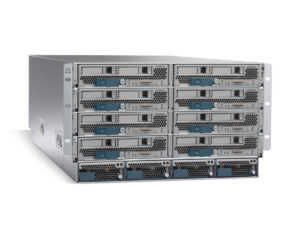
The intimate group included just two vastly different organizations. Yet, a UCS-based integrated stack was the heart of each of their plans. The first company, a top 5 energy provider, is in the process of upgrading the hardware for their Unified Communications installation. They're planning for better uptime from their internal voice system than most of us get from a traditional land line carrier and are getting the best equipment possible to ensure their goal can be met. The second company is a regional consumer finance provider and all their employees together could meet in one floor of the large organization's skyscraper. They'd decided to simplify their lives and prepare from growth by replacing a hodgepodge of server hardware supporting a Microsoft Hyper-V deployment with a couple of UCS racks full of blades.
This small sample exactly parallels what we're hearing from the broader market - small companies moving quickly to datacenters based on Flexpod (UCS/NetApp packages) while large organizations follow a vBlock (UCS/EMC packages) path on a project-by-project basis.
Even in this small group I heard reinforcing evidence around two broadly emerging operations issues - the complexity of multi-silo management and the challenge of troubleshooting in very dynamic datacenters.
During the class, we configured storage, virtualization, and of course compute and network resources. Every time we switched from one administration console to another, our instructor had to explain that the vocabulary in one tool was different than the last. At Zenoss we talk about the complexity of multi-silo management and how difficult it is for storage, networking, virtualization, and compute administrators to work together. Of course that's because we bring data from all the silos into one interface. I experienced first-hand how complex multi-silo management is without that unified view. If you haven't been hands-on in all the silos yourself lately, it's worth a day to see how challenging it is.
The second challenge, troubleshooting in a dynamic datacenter, came up when we started talking about how to divide administration of a UCS installation between two different groups. Our instructor recommended a UCS service profile naming standard to help make the organizational division clear. Then we started talking about how the UCS administrator might figure out which server was running on a blade, and how the OS administrator might try to figure out where his OS was running. The ability of a UCS system to dynamically change the OS-to-blade relationship creates a new kind of problem for troubleshooting. What's running on that blade? It depends. You can figure it out by matching network configuration settings in the OS and the blade, but it's kind of painful and slow. It's really something that should be automated into, I don't know, some kind of real-time model. Hey, Zenoss has one of those!
After the class, the instructor and I chatted. Last year he'd stopped and thought about his career as a datacenter architect and about the impact of integrated stacks on his future. His conclusion was everything was going to change. "Companies won't be doing datacenter architecture, they'll be buying UCS or HP or IBM stacks where the architecture is already done. I don't like to use the 'cloud' word," he told me. "But it's obvious that people will be signing up for capacity from a pool. Automation is going to be critical."
A very talented datacenter architect telling me architecture is done. Mainstream organizations moving to integrated stacks. I'd say the wave is here! When it reaches you, it's time to talk to us. Zenoss was designed and purpose-built for this new world.






